
Home
Preamble
Index
Areas
Hills
Lakes
Dales
Map
References
Me
Drakkar
Saunterings: Walking in North-West England
Saunterings is a set of reflections based upon walks around the counties of Cumbria, Lancashire and
North Yorkshire in North-West England
(as defined in the Preamble).
Here is a list of all Saunterings so far.
If you'd like to give a comment, correction or update (all are very welcome) or to
be notified by email when a new item is posted - please send an email to johnselfdrakkar@gmail.com.
206. Up, Up and Away
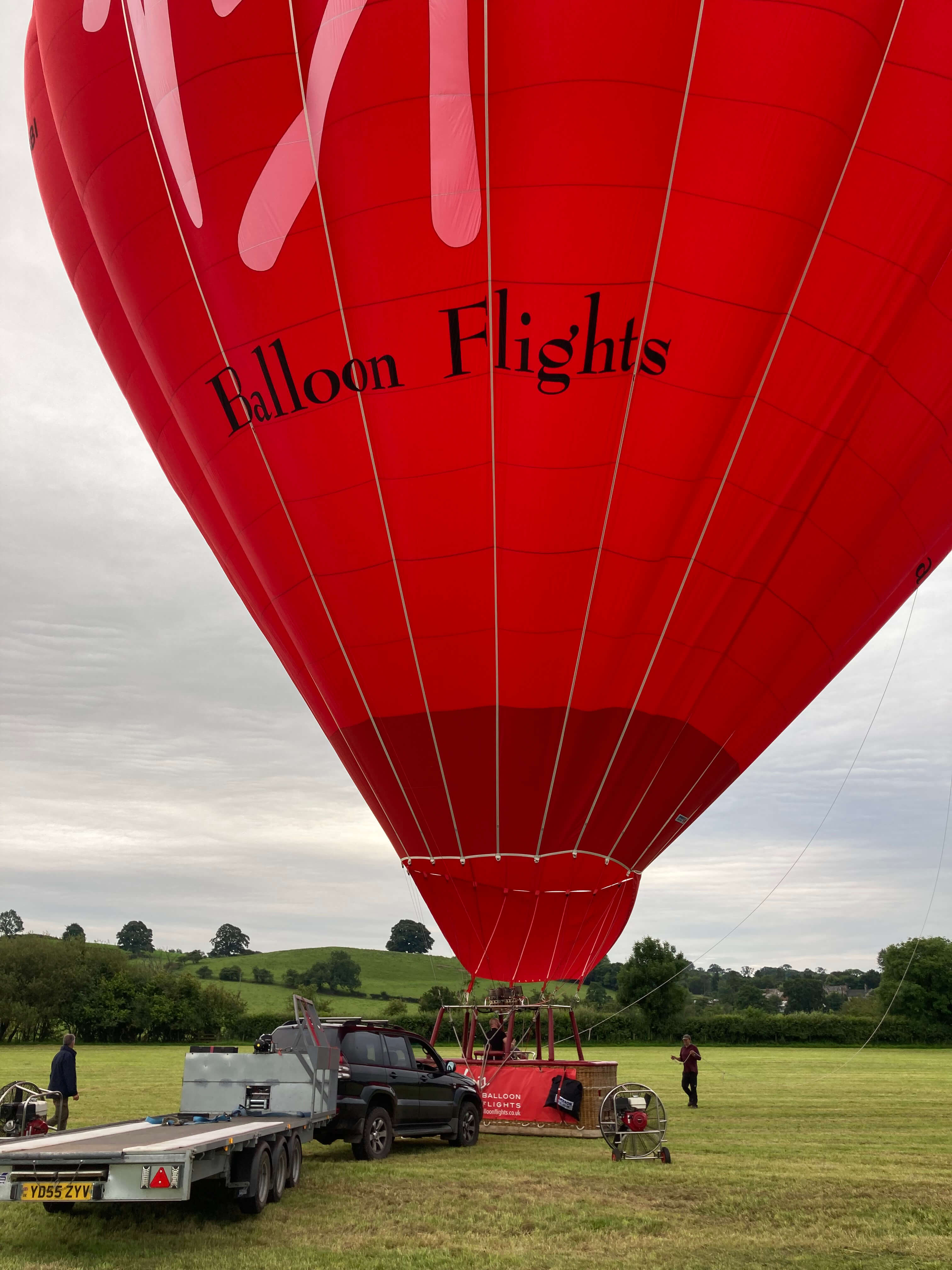 The origins of the word ‘saunter’ are obscure. Some think it comes from the French:
from s’aventurer (to venture) or from sentier (path) or from sainte terre (referring
to pilgrimages to the Holy Land) or from sans terre (referring to nomads wandering
about without land). Or perhaps it’s related to the German schlendern, Dutch slenteren,
Danish slentre, Swedish släntra, and/or Icelandic slentur, all meaning ‘to stroll’.
Or perhaps it’s just a good Old English word. At all events, it has come to mean ‘to
wander about idly’, according to my dictionary.
The origins of the word ‘saunter’ are obscure. Some think it comes from the French:
from s’aventurer (to venture) or from sentier (path) or from sainte terre (referring
to pilgrimages to the Holy Land) or from sans terre (referring to nomads wandering
about without land). Or perhaps it’s related to the German schlendern, Dutch slenteren,
Danish slentre, Swedish släntra, and/or Icelandic slentur, all meaning ‘to stroll’.
Or perhaps it’s just a good Old English word. At all events, it has come to mean ‘to
wander about idly’, according to my dictionary.
Wandering about idly seems to imply walking. If you were to run then that’s not idling.
If you took a mode of transport (car, bus, train and so on) designed to get you from A
to B faster than you could walk it then that’s not idling either. There is, however,
one mode of transport for wandering about idly: the hot-air balloon. You
can’t hurry in a hot-air balloon. You can travel only as fast as the wind allows – and
there shouldn’t be much wind at all. You can’t really aim to get anywhere particular
either. You can only go where the wind takes you. Can you saunter in a hot-air
balloon? I don't think you can do anything else.
Sixteen of us gathered in the Bull Beck car park. Another thing you cannot
dictate with hot-air balloons is where you start. That is a decision for the pilot.
The booking listed a number of possibilities: Cartmel, Crook o’Lune, Graythwaite Hall
(Newby Bridge), Kirkby Lonsdale, Witherslack or Yealand Conyers. I’d have preferred a
Lake District trip myself, soaring over the lakes and mountains, but it is of course
hard to guarantee that you’d land safely there, and anyway there was a forecast of
rain in that region. So we two walked to the gathering point, which was convenient
for us but less so for the other fourteen.
A small trial balloon was released and rose directly
up until it disappeared from view, indicating that if we did get aloft we wouldn’t be blown far.
We moved on to the fields next to the River Lune but found them recently
sprayed with manure. So we were whisked a few miles up the valley, to a field near
Melling.
There is more to a balloon trip than just standing in the basket. It is
all part of the experience to help with the activities before and after the actual
ascent. The basket was placed on its side, with the balloon extracted from its bag
and spread out in a long thin line across the field. It was then unwrapped to lay
flat on the ground. Two fans blew air into the balloon, which gradually rose. When it
was partially aloft gas flames blasted hot air into it and as the balloon continued
to rise the basket was pulled upright – and eventually we all clambered in.
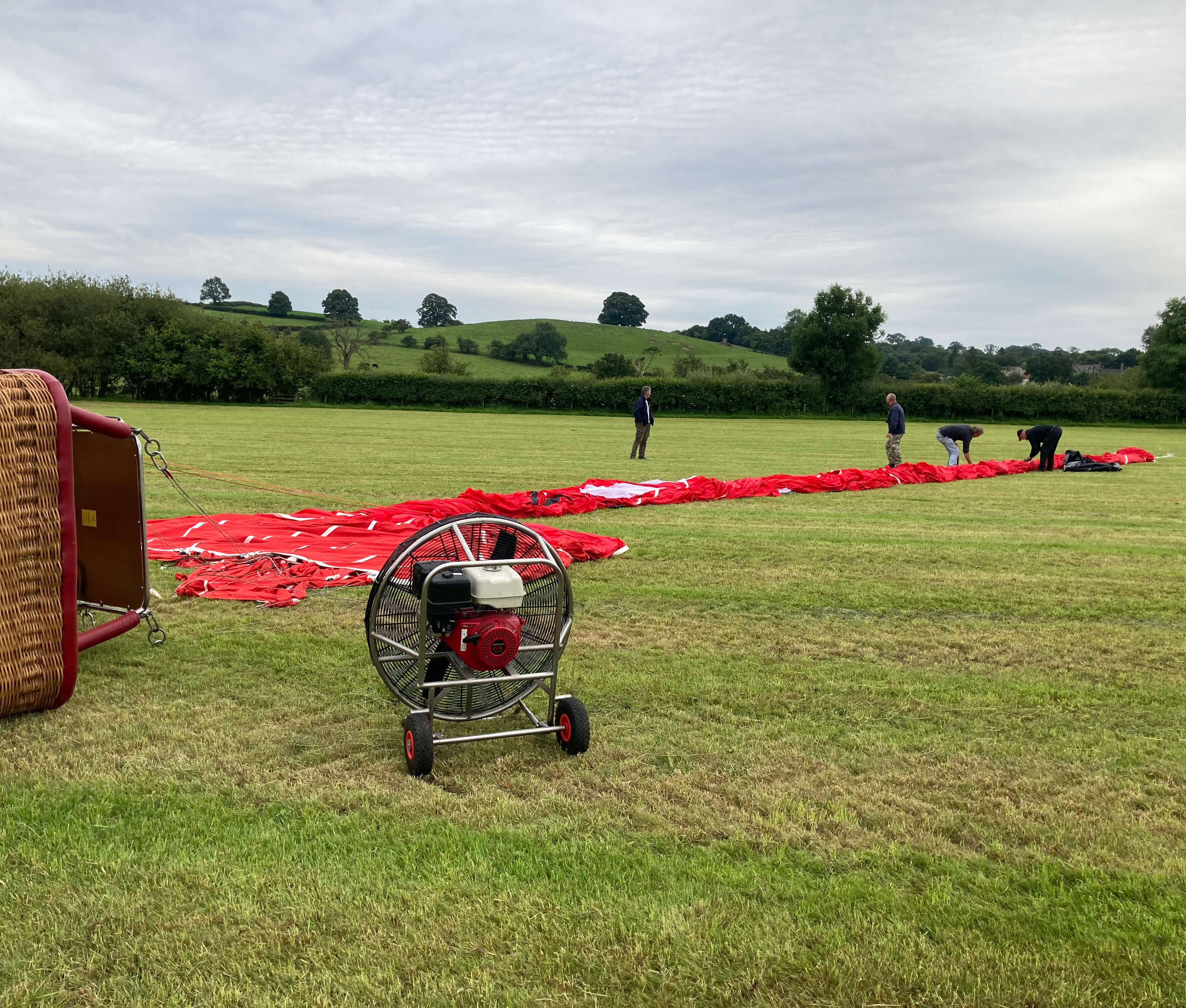
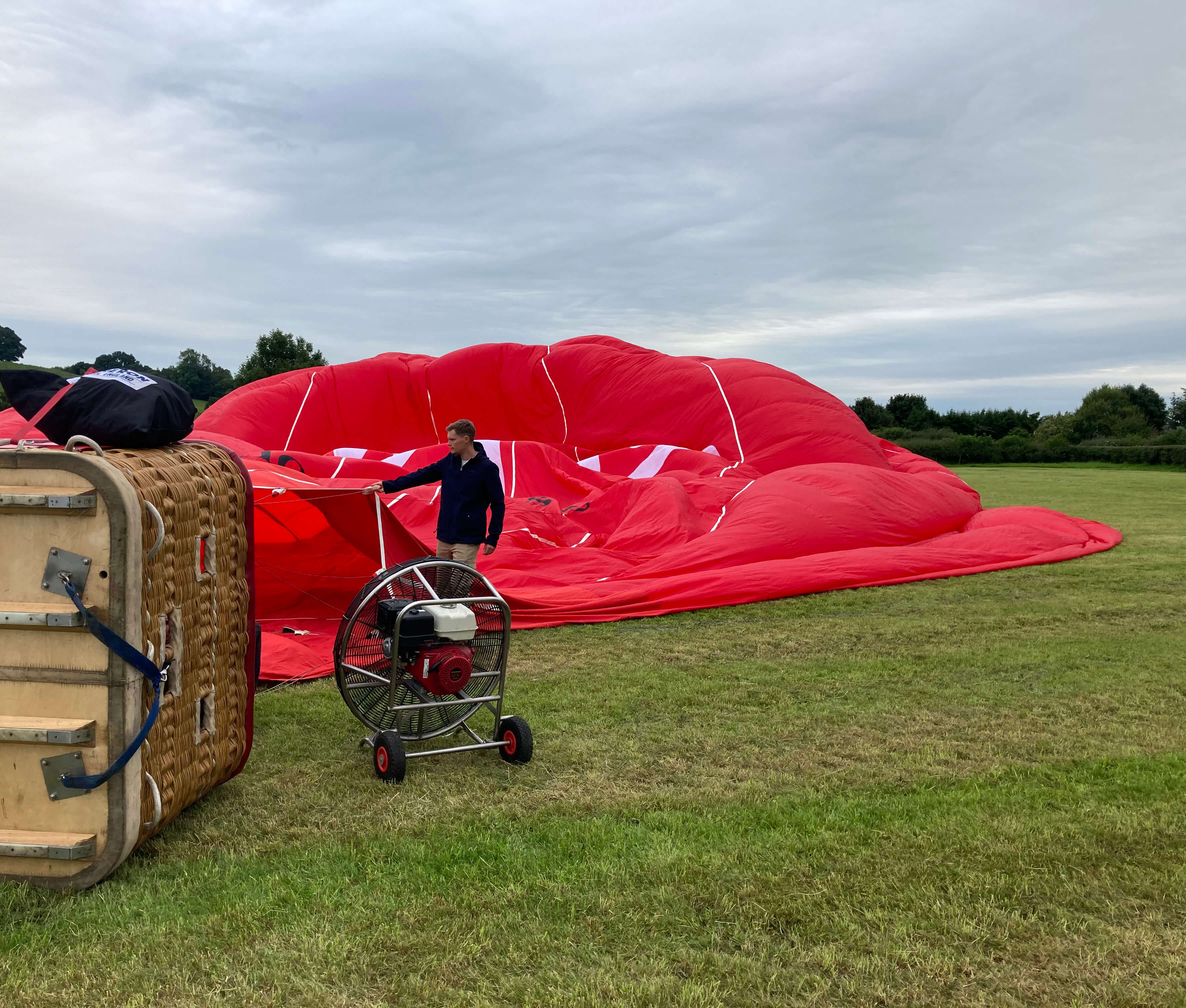
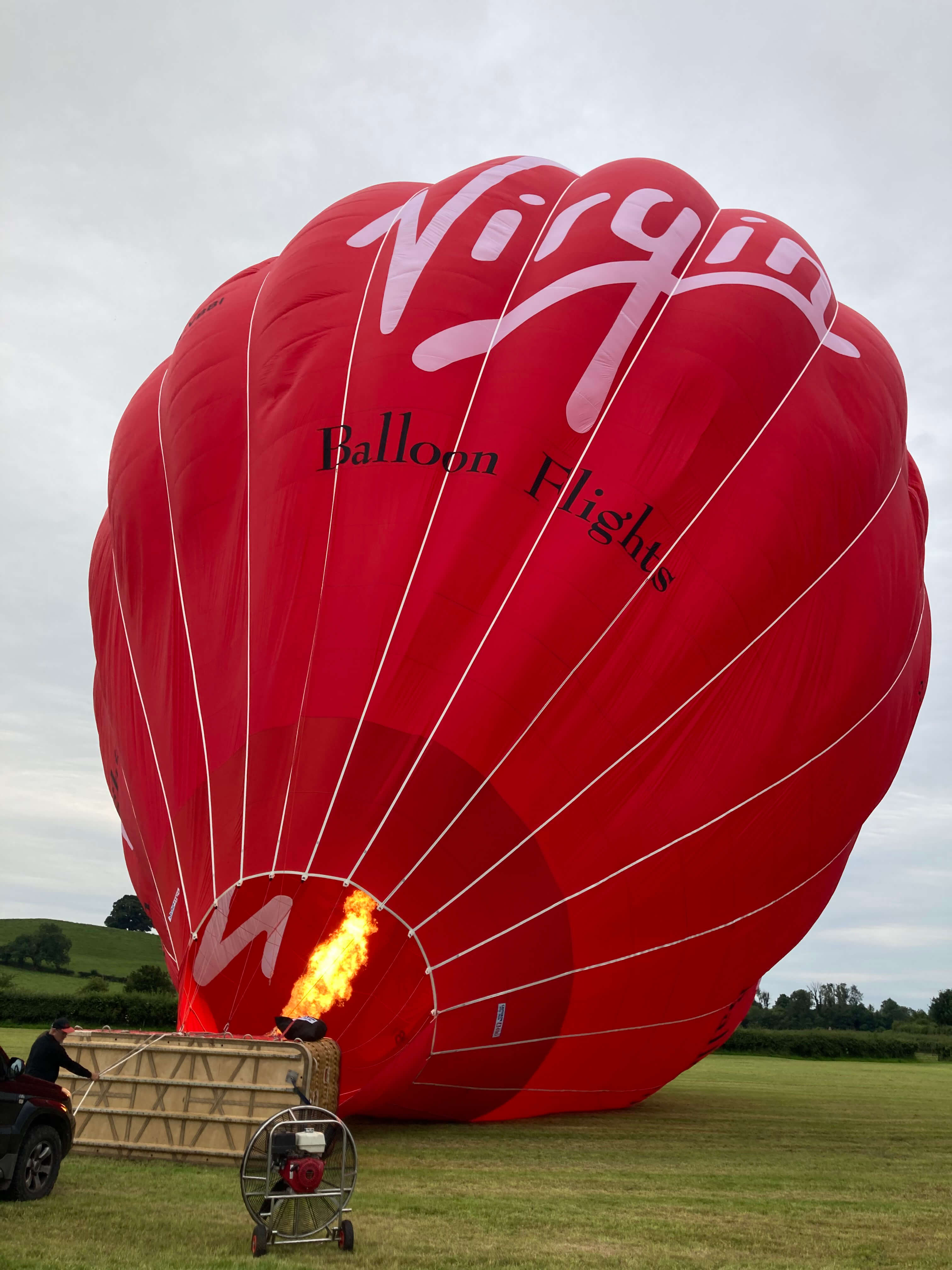
The first movements were imperceptible. Only by looking at the grass below
could you tell that you were no longer on the ground. I’m not sure how much control
the pilot has over all this. It seemed to me that we were travelling slowly horizontally
but hardly vertically at all – we barely crested the hedge by the road-side. Anyway,
we were soon well aloft, with views across to Ingleborough and below to fields where
cows were at first intrigued and then alarmed by us. Understandably, because our
periods of serene movement were broken by ferocious roars.

Aloft, approaching the Lune
We glided north-westwards, towards the River Lune. As we crossed the river,
our pilot performed one of his party tricks (perhaps his only one, as this is a
serious business for him) to reassure us that he was in full command of his craft.
He called it a ‘splash and dash’. As we crossed the river he dipped the basket in
it (like a swallow taking a sip) and then took us swiftly up. Then, from a height
of 200 metres or so, we could reflect on the implausibility of our situation – being
suspended here below a very large balloon – and admire the view below and in all
directions. Because we were travelling with whatever wind there was, there was no
sense of movement. Instead the land below was gliding gently along.
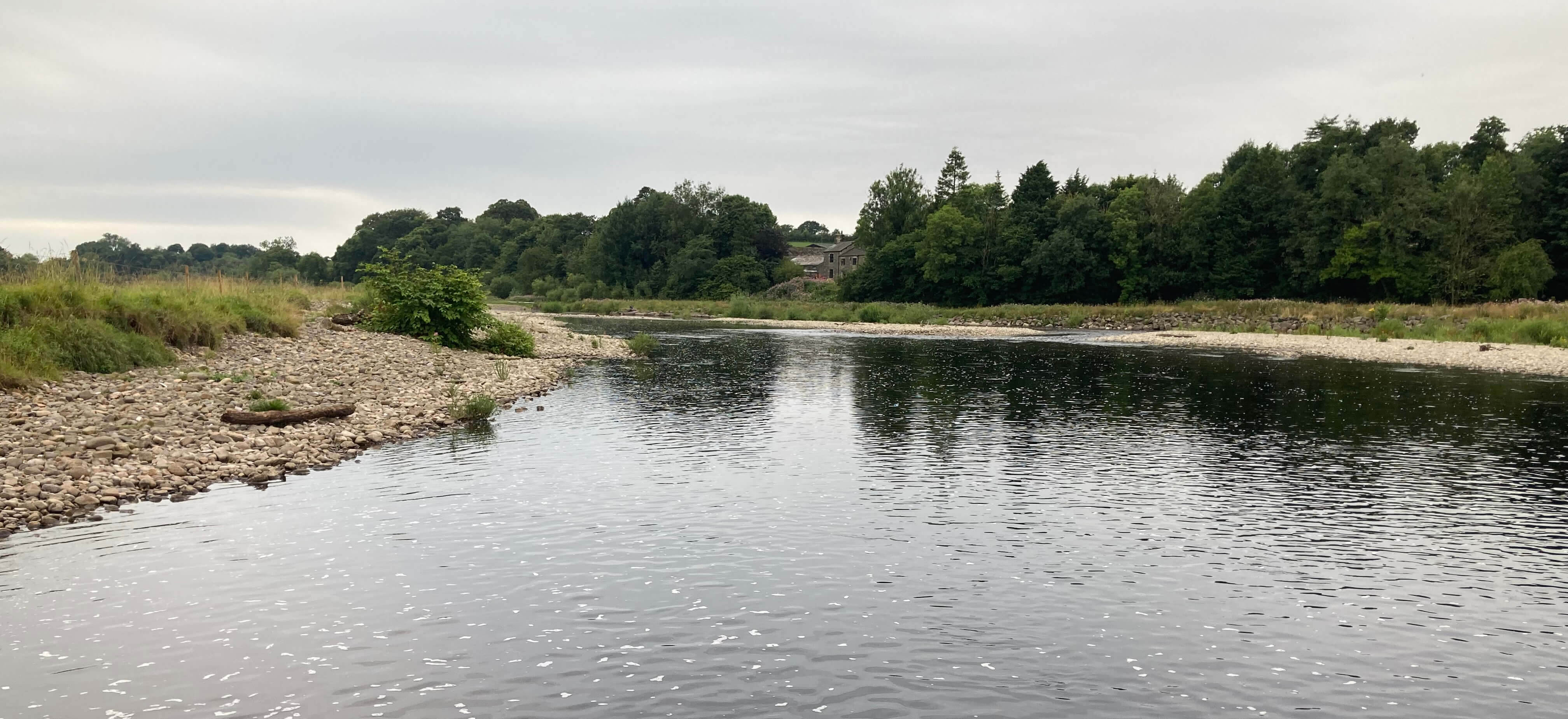
Splashing and dashing
Close by we could see the Carnforth-Wennington railway line crossing the Lune.
In the past I had been puzzled by the fact that the Lune is squeezed through the
second of six not particularly large arches. Just to the east are a further sixteen
arches over a large puddle. From the air it is entirely believable that when the
viaduct was built in the 1860s the River Lune flowed under those sixteen arches, as well
as or perhaps instead of
where it is today.
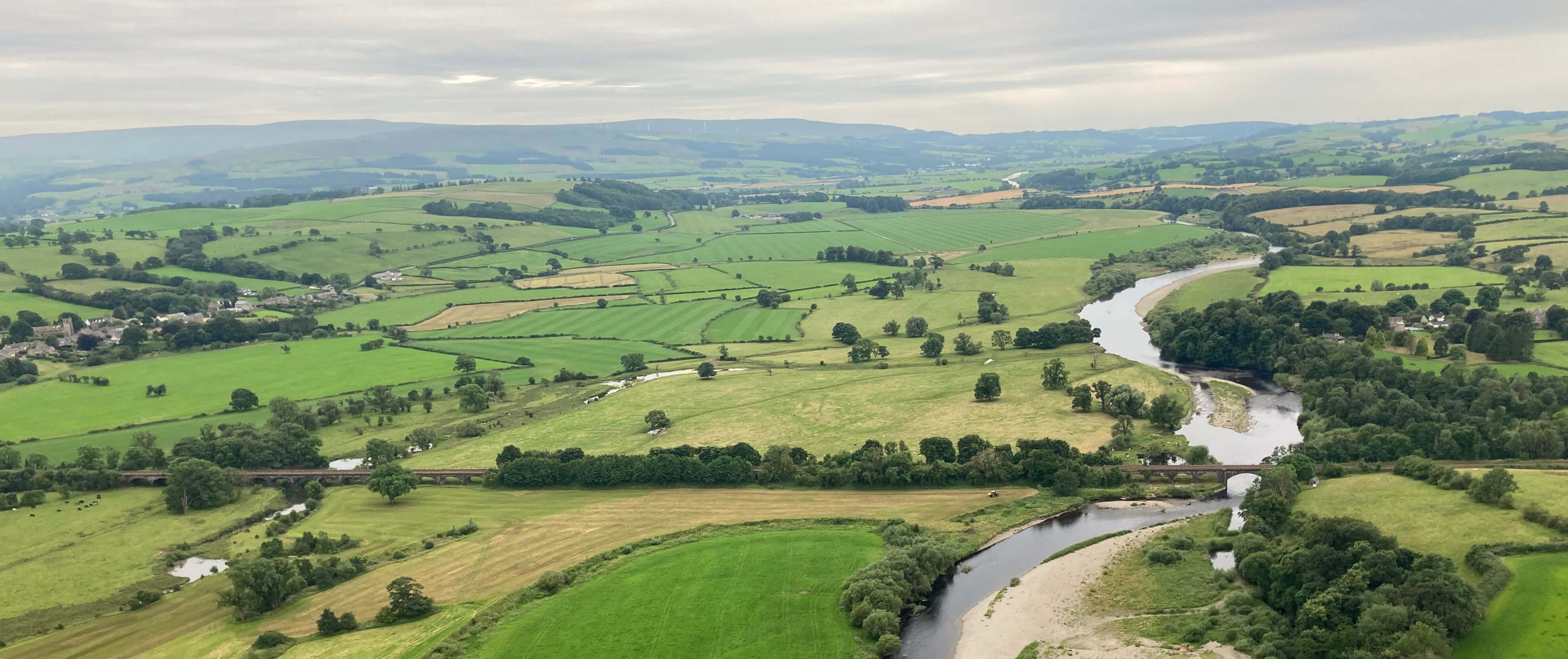
Looking south, with the Arkholme viaduct in the near distance
Also directly below I could trace my footsteps on previous Saunterings – from
Kirkby Lonsdale (50) and following the
Brontë sisters’ footsteps (151). We could see
Thurland Castle, which on the latter walk was hidden from view. The village of
Tunstall was laid out below, with the path to what is sometimes a large island, where
I had walked amongst huge trees washed down in floods.
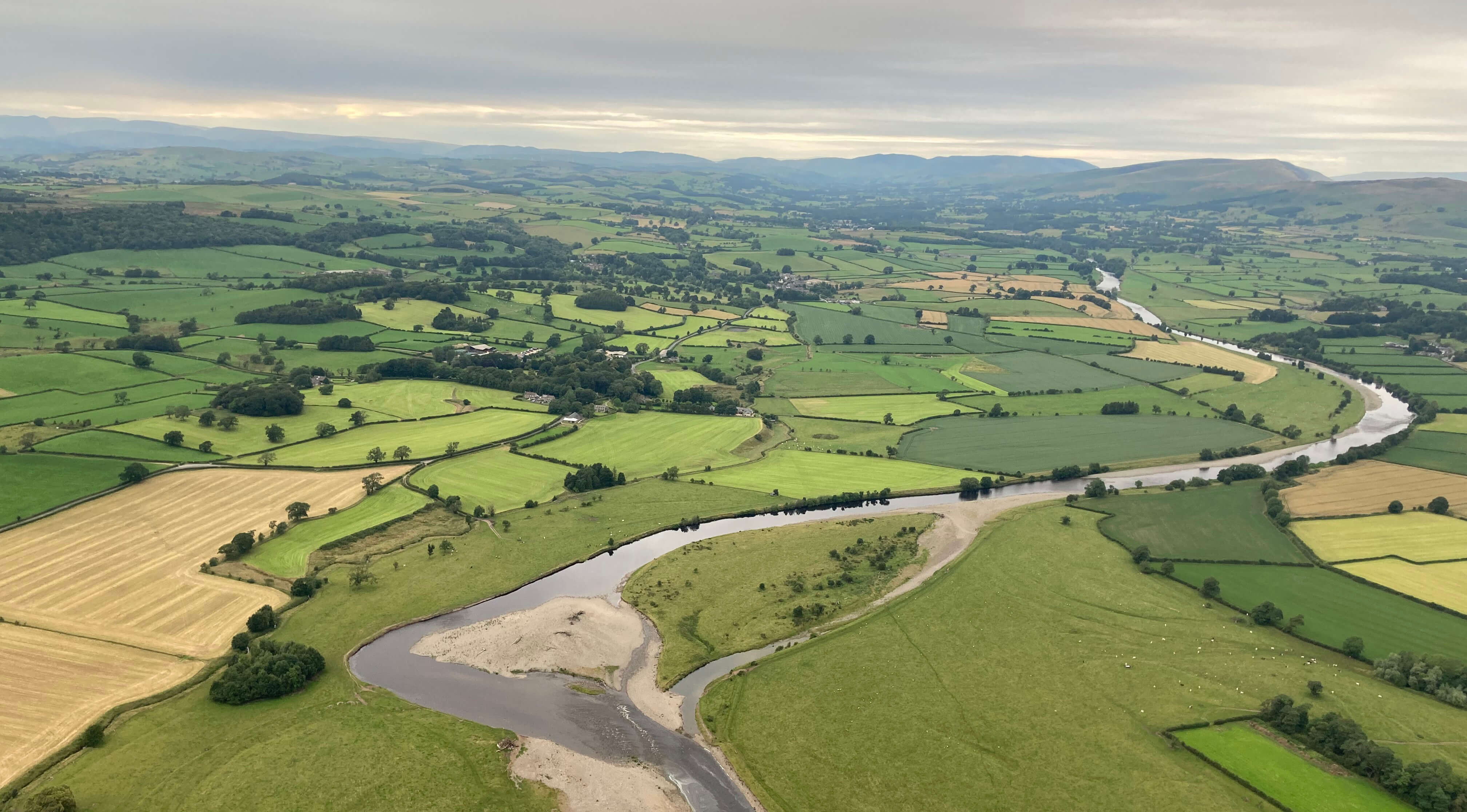
Looking north, with the sometime Tunstall island below
Further afield we could see that the Lake District was indeed in rain, as
forecast. While the views of Morecambe Bay, the Bowland hills, Ingleborough, Gragareth,
and Barbon Fell were clear, they were disappointingly grey because of the cloud.
After wandering idly about for a while we began a descent near Nether Burrow.
It seems that the pilot has some control of our direction of travel. There is no
steering wheel, of course, but he seems to know where the winds at different levels
and in different places blow, sufficient at least for him on this occasion to be able
to manoeuvre the craft back east of the river, for the
convenience of the land-bound crew. The pilot had in his hand a map marking (with
green rings) fields where farmers are happy for the balloon to land, their acquiescence
secured by the occasional bottle, and a few fields (with red rings) to avoid. We all
took up our landing positions, seated and braced for impact (sometimes the basket
bounces and may even tip over). We landed with scarcely a bump.
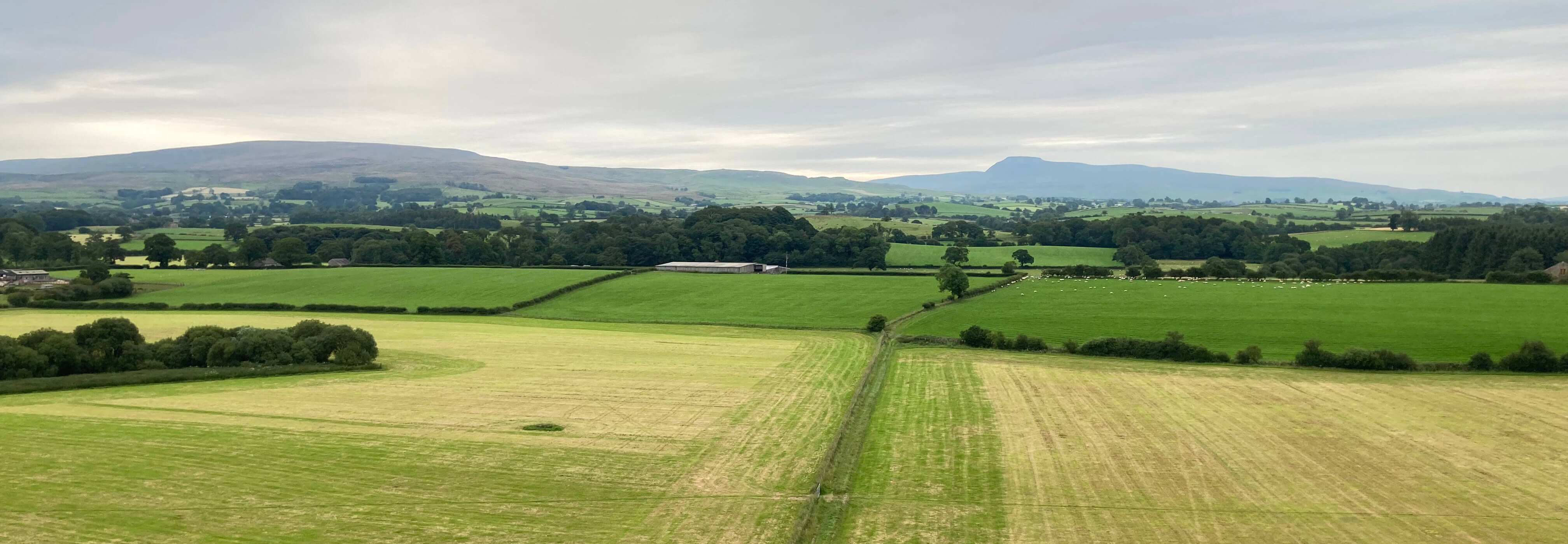
Approaching touch-down, Ingleborough in the distance
Then the process of dismantling the balloon began. A nifty large flap at the
top of balloon was removed to enable the hot air to escape. As the balloon subsided,
we were allowed to walk inside it, where we were given various statistics about the
balloon which I didn’t make a note of. Suffice to say, this is (I think) the largest
balloon in the UK. In due course, the balloon became empty and was then rolled up by
us all to get it squeezed into a surprisingly small bag.
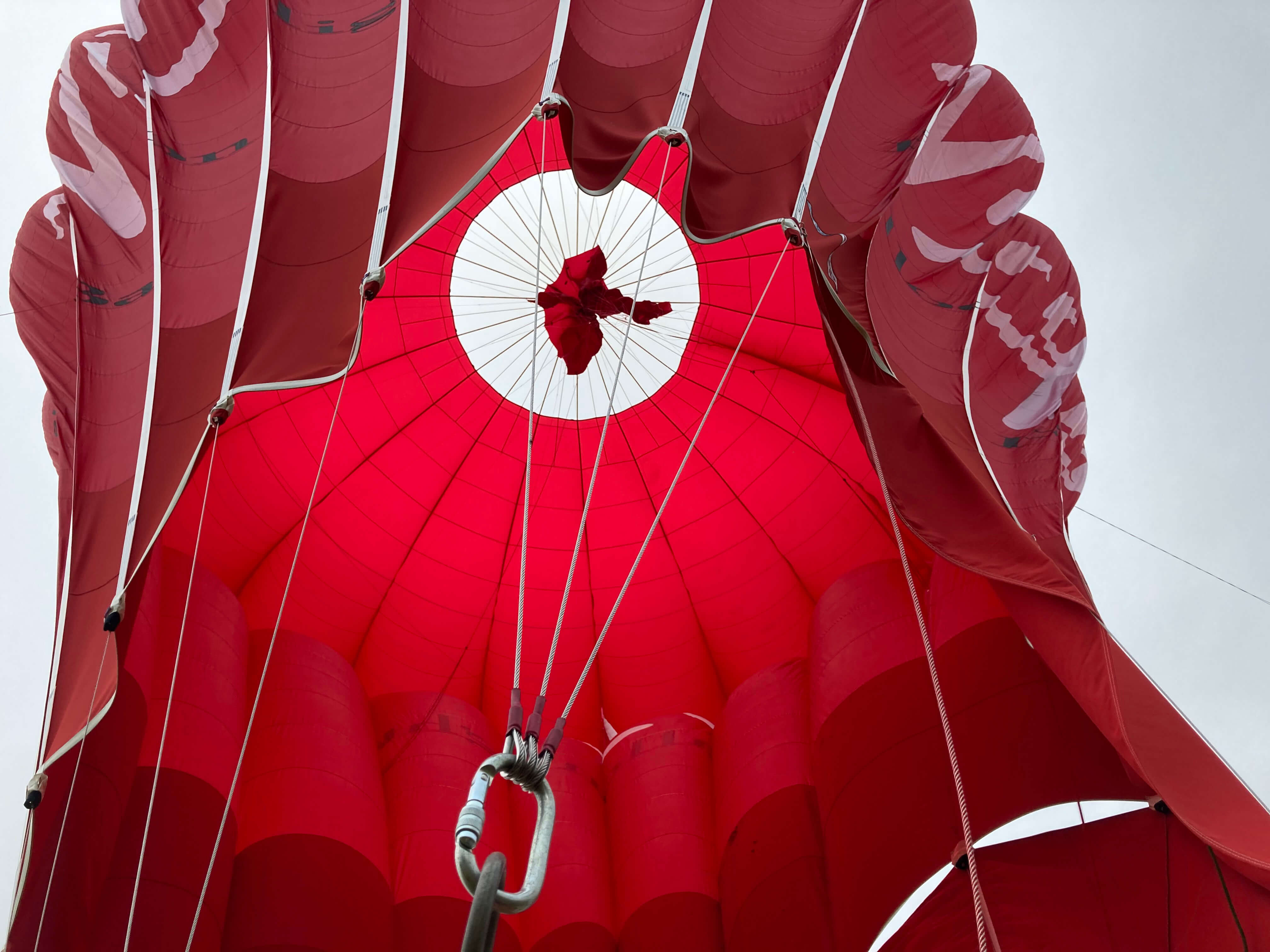
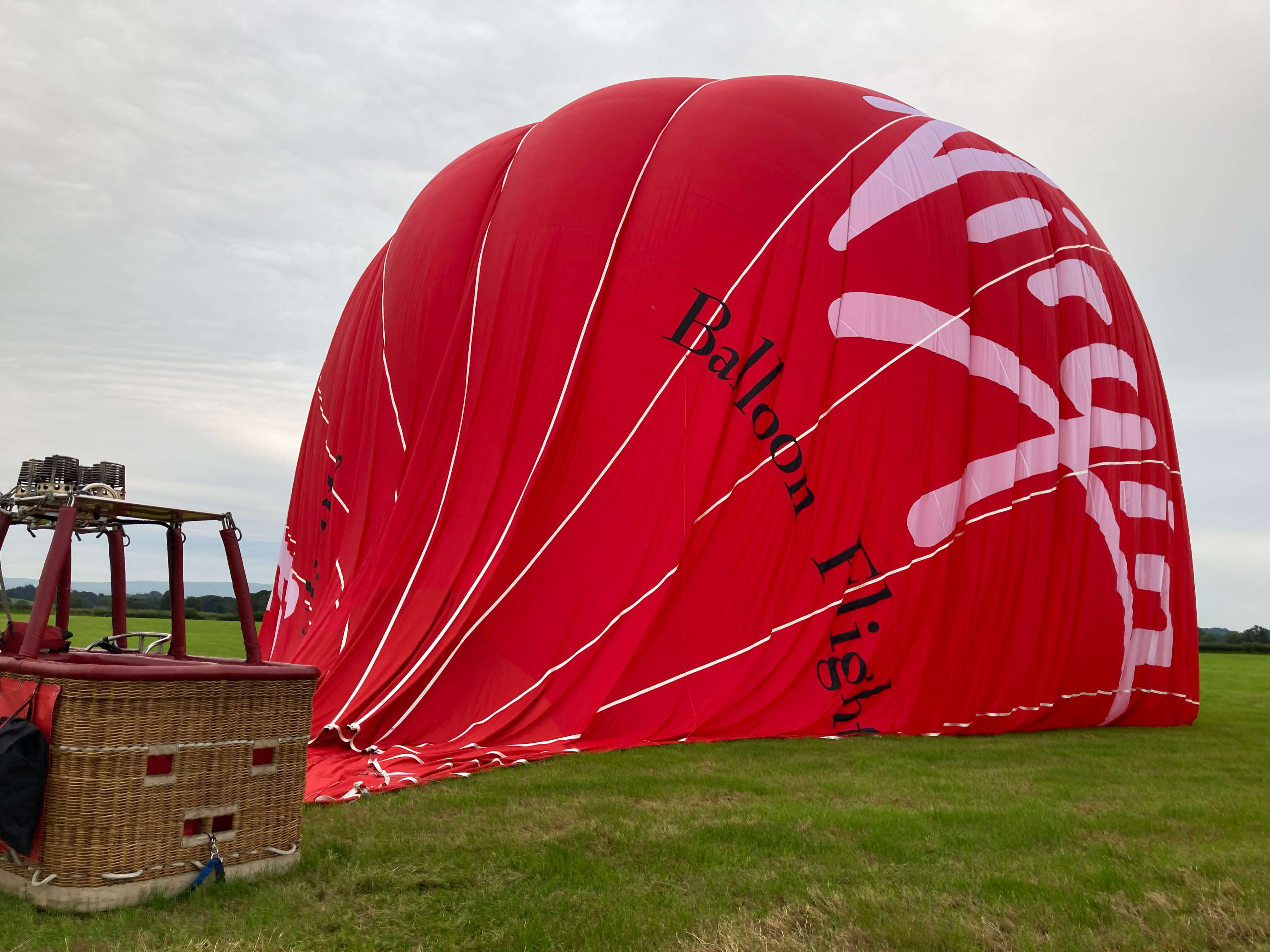
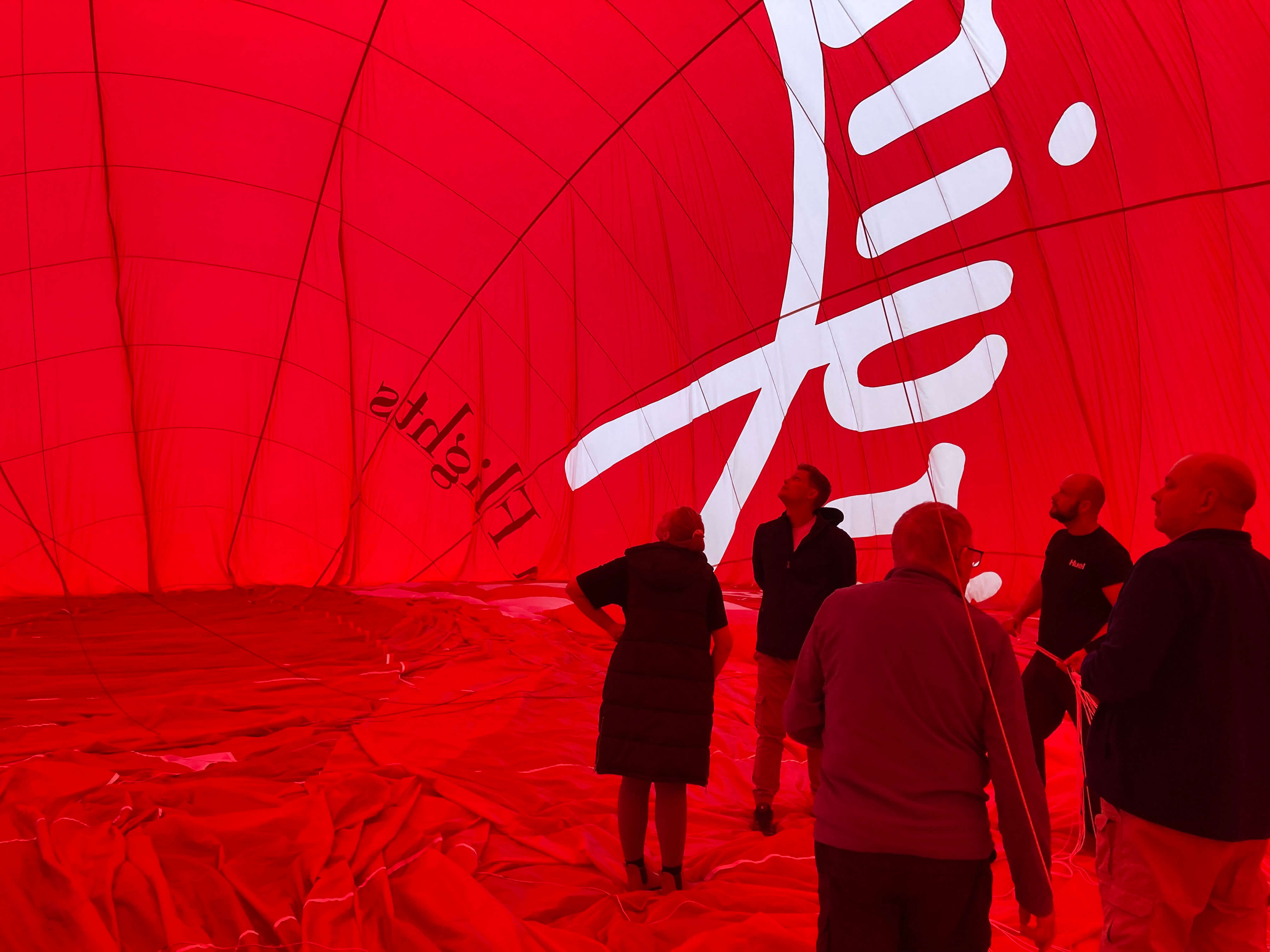
Overall, a hot-air balloon flight is the proverbial once-in-a-lifetime event.
Yes, the novelty is certainly worth experiencing once – but it doesn’t feel necessary
to do so twice. Maybe the novelty has worn off recently, now that we can virtually
soar over the landscape at will with systems such as Google Earth.
In case it should seem that a balloon flight is a simple soothing experience
I will mention that it is not as straightforward as it may seem – it’s not like
catching a bus, where you just turn up at a bus-stop. You have to book the flight
a couple of months ahead and then wait to see whether and where it happens. This
flight was our thirteenth booking. Seven of the previous twelve were cancelled because
of the weather – five of those being no surprise to us, as it was clearly too wet and windy, and
twice we got as far as standing in a field next to a basket while the pilot did his
last-minute calculations and concluded, sorry, that it just wasn’t safe to set off.
Four times we had to cancel, for various reasons. And once the queen’s death caused
a cancellation. For many busy people all this booking and re-booking (and if they
live far from the launching sites all the frustrated travel) would be too much trouble.
We accepted it as part of the fun.
Finally, the question must be asked nowadays: how green is a balloon flight? The short
answer is: it’s not. An average balloon flight produces about 200kg of carbon dioxide
(which responsible flight companies will carbon offset), using enough natural gas to
drive a car for more than 1,000 kilometres. At least, for four hours (before, during
and after a flight) seventeen people are not driving anywhere.
P.S. Up, Up and Away is a song
written by Jimmy Webb and voted Song of the Year 1968. It begins:
Would you like to ride in my beautiful balloon
We could float among the stars together, you and I ...
We didn't float quite that high.
Date: July 18th 2024
Start: SD602718, in a field north of Melling (Map: OL2)
Route: roughly N
Distance: 3 miles as the crow flies (but we didn't fly as the crow); Ascent: 200 metres
Home
Preamble
Index
Areas
Hills
Lakes
Dales
Map
References
Me
Drakkar
© John Self, Drakkar Press, 2018-

Top photo: Rainbow over Kisdon in Swaledale;
Bottom photo: Ullswater


 The origins of the word ‘saunter’ are obscure. Some think it comes from the French:
from s’aventurer (to venture) or from sentier (path) or from sainte terre (referring
to pilgrimages to the Holy Land) or from sans terre (referring to nomads wandering
about without land). Or perhaps it’s related to the German schlendern, Dutch slenteren,
Danish slentre, Swedish släntra, and/or Icelandic slentur, all meaning ‘to stroll’.
Or perhaps it’s just a good Old English word. At all events, it has come to mean ‘to
wander about idly’, according to my dictionary.
The origins of the word ‘saunter’ are obscure. Some think it comes from the French:
from s’aventurer (to venture) or from sentier (path) or from sainte terre (referring
to pilgrimages to the Holy Land) or from sans terre (referring to nomads wandering
about without land). Or perhaps it’s related to the German schlendern, Dutch slenteren,
Danish slentre, Swedish släntra, and/or Icelandic slentur, all meaning ‘to stroll’.
Or perhaps it’s just a good Old English word. At all events, it has come to mean ‘to
wander about idly’, according to my dictionary.











